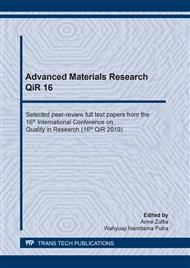[1]
L.P. Borilo, L.N. Spivakova, Synthesis and characterization of ZrO2 thin films, Am. J. Mat. Sci. 2 (2012) 119-124.
Google Scholar
[2]
Y.L. Guo, S.G. Long, R. Talle, Effect of dopants on the corrosion behaviour of zirconia by steel at high temperature, Key Eng. Mat. 999 (2007) 280-283.
DOI: 10.4028/www.scientific.net/kem.280-283.999
Google Scholar
[3]
W. Liu, Y. Chen, C. Ye, P. Zhang, Preparation and characterization of doped sol-gel zirconia films, Ceram Int. 28 (2002) 349-354.
DOI: 10.1016/s0272-8842(01)00101-8
Google Scholar
[4]
H.G. Sun, S.Z. Yan, P.T. Li, Q.H. Tan, A.J. Wu, Effects of monoclinic ZrO2 with different particle size on properties of zirconia refractories, Adv. Mat. Res. 721 (2011) 335-336.
DOI: 10.4028/www.scientific.net/amr.335-336.721
Google Scholar
[5]
X.X. Li, L. Chen, B. Li, L. Li, Preparation of zirconia nanopowders in ultrasonic field by the sol-gel method, Key Eng. Mat. 981 (2007) 280-283.
DOI: 10.4028/www.scientific.net/kem.280-283.981
Google Scholar
[6]
M.S. Jamil, KE Saputro, A. Noviyanto, W.B. Widayatno, A.S. Wismogroho, M.I. Amal, N.T. Rochman, T. Nishimura. Dense and fine-grained barium titanate prepared by spark plasma sintering, Journal of Physics: Conference Series 1191 (2019) 012039.
DOI: 10.1088/1742-6596/1191/1/012039
Google Scholar
[7]
A. Saccà, I. Gatto, A. Carbone, R. Pedicini, S. Maisano, A. Stassi, E. Passalacqua, Influence of doping level in Yttria-Stabilised-Zirconia (YSZ) based-fillers as degradation inhibitors for proton exchange membranes fuel cells (PEMFCs) in drastic conditions, Int. J. Hydrog. Energy 44 (2019) 31445-31457.
DOI: 10.1016/j.ijhydene.2019.10.026
Google Scholar
[8]
M. Turon-Vinas, F. Zhang, J. Vleugels, M. Anglada. Effect of calcia co-doping on ceria-stabilized zirconia. J. Eur. Ceram. Soc. 38 (2018) 2621-2631.
DOI: 10.1016/j.jeurceramsoc.2017.12.053
Google Scholar
[9]
F.Yu, J. Xiao, L. Lei,W. Cai, Y. Zhang, J. Liu, M. Liu, Effects of doping alumina on the electrical and sintering performances of yttrium-stabilized-zirconia, Solid State Ion. 289 (2016), 28-34.
DOI: 10.1016/j.ssi.2016.02.022
Google Scholar
[10]
C.J. Lucio-Ortiz, J.R. De la Rosa, A. Hernandez-Ramirez, E.M. Lopez-Cuellar, G. Beltran-Perez, R.D.C.M. Guardiola, C.D. Pedroza-Solis, La-, Mn- and Fe-doped zirconia catalysts by sol-gel synthesis: TEM characterization, mass-transfer evaluation and kinetic determination in the catalytic combustion of trichloroethylene, Colloid Surface A 371 (2010) 81-90.
DOI: 10.1016/j.colsurfa.2010.09.008
Google Scholar
[11]
N.P.F. Gonçalves, M.C. Paganini, P. Armillotta, E. Cerrato, P. Calza, The effect of cobalt doping on the efficiency of semiconductor oxides in the photocatalytic water remediation, J. Environ. Chem. Eng. 7 (2019) 103475.
DOI: 10.1016/j.jece.2019.103475
Google Scholar
[12]
H. McMurdie, M. Morris, E. Evans, B. Paretzkin, W. Wong-Ng, C.Hubbard, Standard X-ray diffraction powder patterns from the JCPDS research associateship, Powder Diffr. 1 (1986) 64-77.
DOI: 10.1017/s0885715600011593
Google Scholar
[13]
K. Martin, G. McCarthy, ICDD Grant-in-Aid, North Dakota State University, North Dakota, USA, (1990).
Google Scholar
[14]
K. Markandan, J.K. Chin, M.T.T. Tan, Study on Mechanical Properties of Zirconia-Alumina Based Ceramics, Appl. Mech. Mater. 625 (2014) 81–84.
DOI: 10.4028/www.scientific.net/amm.625.81
Google Scholar
[15]
H. Reverón, H. Vesteghem, Sintering Behaviour of Zirconia and Ceria-Doped Zirconia Powders Cristallized under Hydrothermal Conditions, Key Eng. Mater. 206–213 (2001) 183–188.
DOI: 10.4028/www.scientific.net/kem.206-213.183
Google Scholar
[16]
G.N. Shao, S.M. Imran, S.J. Jeon, M. Engole, N. Abbas, M.S. Haider, S.J. Kang, H.T. Kim, Sol-gel synthesis of photoactive zirconia-titania from metal salts and investigation of their photocatalytic properties in the photodegradation of methylene blue, Powder Technol. 258 (2014) 99-109.
DOI: 10.1016/j.powtec.2014.03.024
Google Scholar


